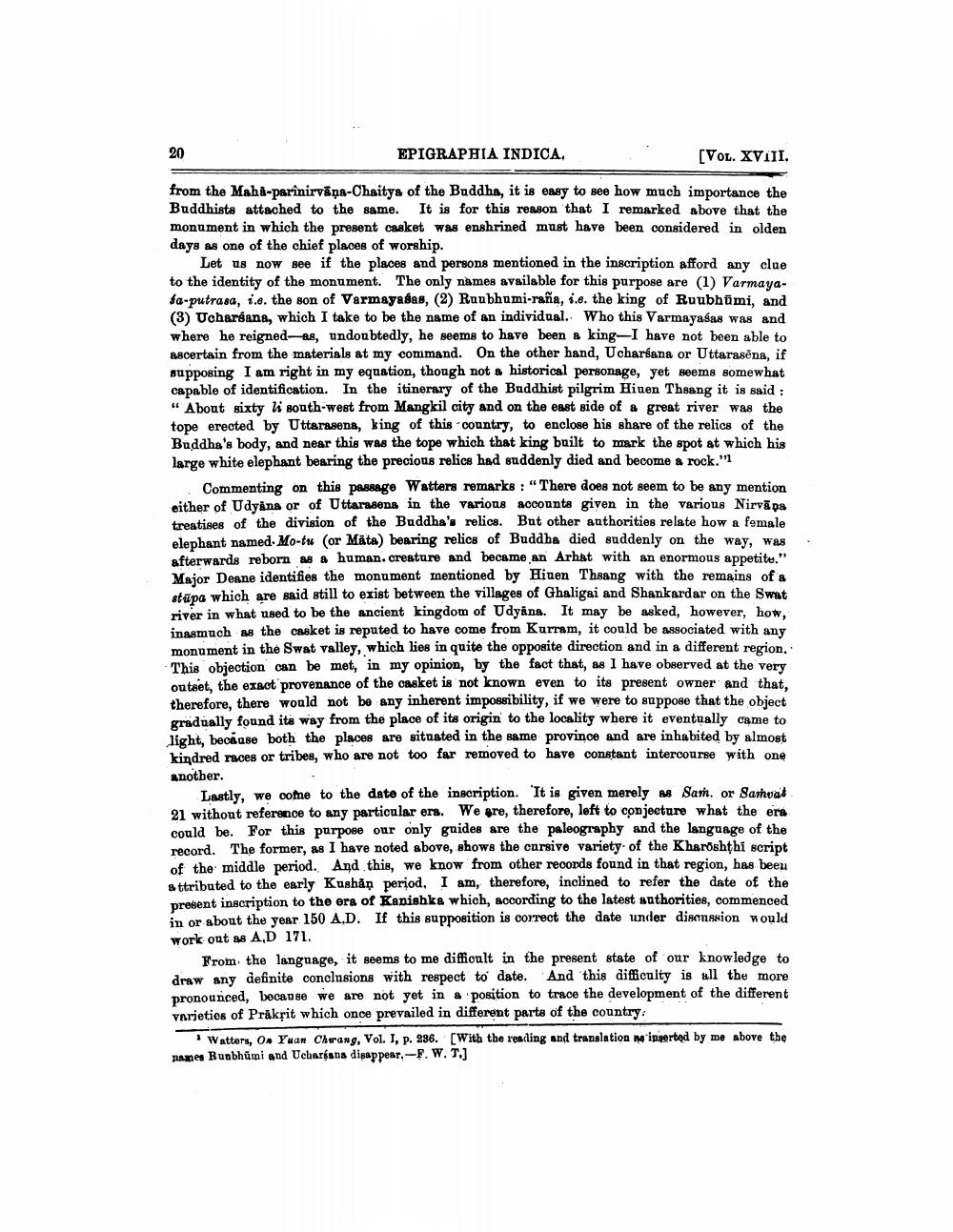________________
20
EPIGRAPHIA INDICA.
[VOL. XVIII.
from the Maha-parinirvana-Chaitya of the Buddha, it is easy to see how much importance the Buddhists attached to the same. It is for this reason that I remarked above that the monument in which the present casket was enshrined must have been considered in olden days as one of the chief places of worship.
Let us now see if the places and persons mentioned in the inscription afford any clue to the identity of the monument. The only names available for this purpose are (1) Varmayasa-putrasa, i.e. the son of Varmayasas, (2) Ruubhumi-raña, i.e. the king of Ruubhumi, and (3) Ucharsana, which I take to be the name of an individual. Who this Varmayasas was and where he reigned-as, undoubtedly, he seems to have been a king-I have not been able to ascertain from the materials at my command. On the other hand, Ucharsana or Uttarasēna, if supposing I am right in my equation, though not a historical personage, yet seems somewhat capable of identification. In the itinerary of the Buddhist pilgrim Hiuen Thsang it is said: "About sixty li south-west from Mangkil city and on the east side of a great river was the tope erected by Uttarasena, king of this country, to enclose his share of the relics of the Buddha's body, and near this was the tope which that king built to mark the spot at which his large white elephant bearing the precious relics had suddenly died and become a rock."
Commenting on this passage Watters remarks: "There does not seem to be any mention either of Udyana or of Uttarasena in the various accounts given in the various Nirvapa treatises of the division of the Buddha's relics. But other authorities relate how a female elephant named. Mo-tu (or Mata) bearing relics of Buddha died suddenly on the way, was afterwards reborn as a human. creature and became an Arhat with an enormous appetite." Major Deane identifies the monument mentioned by Hiuen Thsang with the remains of a stupa which are said still to exist between the villages of Ghaligai and Shankardar on the Swat river in what used to be the ancient kingdom of Udyana. It may be asked, however, how, inasmuch as the casket is reputed to have come from Kurram, it could be associated with any monument in the Swat valley, which lies in quite the opposite direction and in a different region. This objection can be met, in my opinion, by the fact that, as I have observed at the very outset, the exact provenance of the casket is not known even to its present owner and that, therefore, there would not be any inherent impossibility, if we were to suppose that the object gradually found its way from the place of its origin to the locality where it eventually came to light, because both the places are situated in the same province and are inhabited by almost kindred races or tribes, who are not too far removed to have constant intercourse with one another.
Lastly, we come to the date of the inscription. It is given merely as Sam. or Samvat 21 without reference to any particular era. We are, therefore, left to conjecture what the era. could be. For this purpose our only guides are the paleography and the language of the record. The former, as I have noted above, shows the cursive variety of the Kharoshthi script of the middle period. And this, we know from other records found in that region, has been attributed to the early Kushan period. I am, therefore, inclined to refer the date of the present inscription to the era of Kanishka which, according to the latest authorities, commenced in or about the year 150 A.D. If this supposition is correct the date under discussion would work out as A,D 171.
From the language, it seems to me difficult in the present state of our knowledge to draw any definite conclusions with respect to date. And this difficulty is all the more pronounced, because we are not yet in a position to trace the development of the different varieties of Prakrit which once prevailed in different parts of the country:
Watters, On Yuan Cherang, Vol. I, p. 236. [With the reading and translation as inserted by me above the names Runbhumi and Ucharsana disappear.-F. W. T.]




